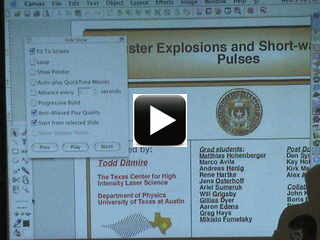In recent years, there has been quite substantial progress in the
understanding of explosions of atomic clusters subject to intense laser
irradiation. It is now well understood that single species clusters of low
Z materials (such as hydrogen or deuterium) expand by a Coulomb explosion
if they are irradiated with enough intensity. In this case, if irradiated
with a pulse of sufficiently fast rise time and sufficiently high intensity
to eject all free electrons from the cluster, the ejected ion energies will
be simply the potential energy of the ions after ionization at their
equilibrium position in the cluster. Large clusters irradiated at modest
intensity exhibit different behavior. Experiments indicate that in this
case collective electron oscillation phenomena are very important in
determining the dynamics of such clusters. It has been found that in an
intensely irradiated cluster, optically and collisionally-ionized electrons
undergo rapid collisional heating for the short time (<1 ps) before the
cluster disassembles in the laser field. Pump-probe experiments indicate
that the cluster microplasma exhibits a resonance in the heating by the
laser pulse similar to the giant resonance seen in metallic
clusters. Charge separation of the hot electrons leads to a very fast
expansion of the cluster ions.
Quite recently, the nature of cluster interactions with intense, short
wavelength light, ie vacuum ultraviolet and extreme ultraviolet, have come
under study. Such studies have now become possible because of the
development of a number of intense, ultrafast sources in the VUV range.These studies are motivated in part by the promise of XFEL imaging of large
protein molecules, an experiment which is similar in many respects to the
interaction of an intense XFEL pulse with a large cluster. The expansion
time and mechanism of these large structures under intense short wavelength
illumination is of great importance to ascertaining the likely success of
such imaging experiments. As such, a complete understanding of the
explosion mechanisms of large clusters (ie. proteins) under intense short
wavelength illumination is critical. Furthermore, such interactions are of
fundamental interest as collective effects, not manifested in long
wavelength laser interactions, may play a part in the
dynamics. Interactions with wavelengths shorter than 10 nm will be quite
different from near IR interactions (at 800 to 1000 nm) since, even at high
intensity, the ponderomotive forces (which scale as I?2) of the XUV pulses
are much smaller than in the IR pulses. As a result, much of the electron
heating and ponderomotive ejection of electrons, which we know to occur at
high intensity in IR pulses, will likely not occur in the short wavelength
pulses. Furthermore, short wavelength pulses will come into resonance with
the giant dipole resonance of a cluster plasma at much higher density than
do IR pulses. These are much more collisional plasmas and the absorption
of energy from the pulse will differ dramatically.
In my talk I will discuss various aspects of the physics of intense XUV and
x-ray interactions with small clusters. I will discuss our plans for using
femtosecond XUV light generated by high order harmonic generation to study
these short wavelength-cluster interactions. I will also consider how very
short pulses of XUV light (few fs) might be used to study the very early
time dynamics of the cluster explosion.
 Other video options
Other video options